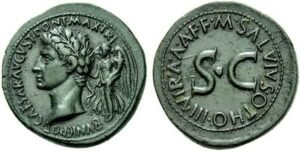How to Identify Roman Coins (Collector’s Guide)
A few years ago, I picked up a worn silver coin with a laurel-wreathed emperor on one side and some kind of goddess on the other. No date. No clear name. Just Latin letters I couldn’t read — and a mystery.
That’s what started my obsession with identifying Roman coins.
If you’re holding one right now and wondering who is this?, you’re in the right place. Let’s walk through the clues that help you decode what’s in your hand — and maybe even uncover something rare.
🔍 Start with the Front: The Emperor’s Portrait
Roman coins almost always have a bust on the front (called the obverse). It’s usually an emperor — sometimes his wife, a general, or even a god.
Here’s what to look for:
-
What’s on their head? A crown, laurel wreath, helmet?
-
Bearded or clean-shaven? Emperors like Hadrian had beards. Augustus didn’t.
-
Which direction is the bust facing? It sounds small, but it helps.
🧠 Quick tip: Even if the name is worn off, the bust style often tells you which emperor it is.
🕊️ The Reverse Tells a Story
Flip the coin over — this side usually shows a message. You might see:
-
Victory with a wreath
-
Mars with a spear
-
An eagle, a Roman temple, or military standards
Think of it like ancient PR. The emperor was showing off military wins, divine approval, or political power.
Metal, Size & Weight Help You Identify the Type
Sometimes the design isn’t enough — especially if it’s worn. That’s where metal and size come in.
Pick up the coin and ask:
-
Is it heavy or light?
-
Silver, gold, or bronze?
-
Big and thick or thin and cracked?
Here’s a quick guide to the most common Roman coin types:
| Coin Type | Metal | Avg. Weight | Notes |
|---|---|---|---|
| Aureus | Gold | ~7g | Early Empire gold coin — high value, thin flan |
| Solidus | Gold | ~4.5g | Late Roman gold, introduced under Constantine |
| Denarius | Silver | ~3.5g | Most common silver coin for 300+ years |
| Antoninianus | Billon (low silver) | ~4.5g | Radiate crown on emperor = double value |
| Sestertius | Bronze | 20–30g | Thick, heavy coin — large canvas for portraits |
| Follis | Bronze | 8–10g | Common in late period — Christian symbols appear |
🧠 Tip: Compare your coin’s size to a modern coin (like a nickel or quarter). Sestertii are large and bold. Denarii are silver and compact.
🔍 Match Your Coin to Known Types
Once you’ve gathered:
-
The emperor or bust style
-
The Latin legend
-
The metal and approximate weight
-
Any symbols or mint marks
…you can now compare it to known coins in catalogs or online.
🛠️ Tools I personally use:
-
WildWinds Roman Coin Database – Great for matching portraits and legends
-
ACSearch.info – Auction history with images and prices
-
British Museum’s Roman Coin Collection – Clean, scholarly examples
You don’t need to be a Latin expert or numismatist to figure it out. Just slow down, observe, and compare. It gets easier — I promise.
📥 Want a Printable Roman Coin Identifier?
I’m putting together a free 1-page cheat sheet that includes:
-
Common abbreviations
-
Portrait clues
-
Mint mark codes
-
Denomination chart
👉 Join the newsletter and I’ll send it straight to your inbox when it’s ready.
🔗 Related Guides on NumisHaven
🎯 Final Thought
The more Roman coins you look at, the more you start to see patterns. The busts, the letters, the reverse types — they all start to feel familiar.
It’s not about memorizing everything. It’s about observation. Curiosity. And a little patience.
And once you decode your first coin?
You’re hooked.
Got a Roman coin you’re struggling to identify? Drop a comment or send us a photo — we’d love to help.
